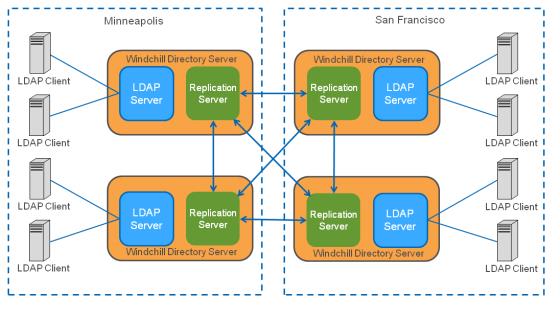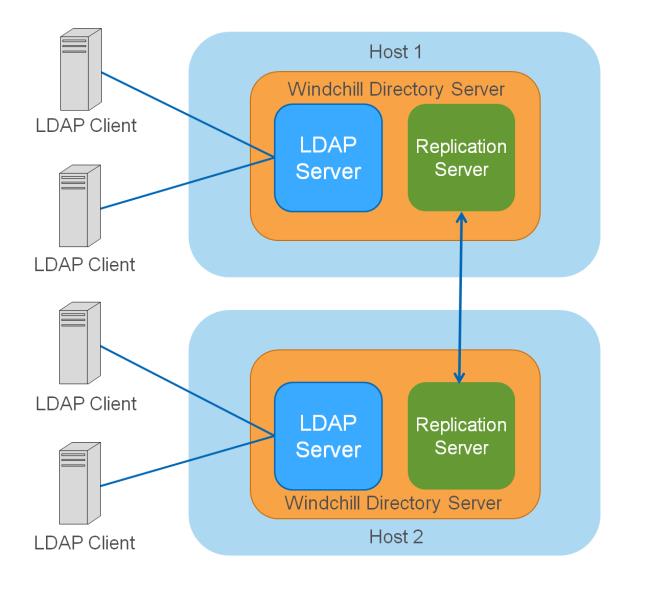Replication
Windchill Directory Server supports replication. Two or more instances of Windchill Directory Server can be configured to contain the same data and replicate changes to other servers in the replication configuration.
|
|
Windchill should not be running while setting up replication for WindchillDS.
|
Windchill Directory Server replication uses a multi-master replication model. That is, directory servers participating in replication can fully respond to LDAP requests that modify directory content as well as LDAP requests that query directory content. A change made on one server will appear, almost immediately, on the other servers.
Replication can be used to provide a basis for high availability. If an LDAP server on one system fails, Windchill can be quickly reconfigured to use an alternate server with no loss of data. Alternatively, a load balancer can be used in front of the directory servers so that failover can occur automatically in the event of an LDAP server failure.
Replication can also be an adjunct to backup. However, it should never replace consistent use of the recommended daily backups and weekly exports. If all servers in a replication configuration have the same baseDNs, and if all baseDNs are being replicated, then a backup needs to be taken on only one server in the replication configuration. If backup is being performed on only one server, the backup (and exports) should be taken consistently from the same server. If the primary server to which Windchill is connected is expected to be heavily loaded, backups and exports could be generated on a different server in the replication configuration. However, the overhead to generate backups and export files should be small, and it is recommended that you generate backups and exports on all servers.
The following diagram illustrates the use of two instances of the Windchill Directory Server set up to replicate data between installations on two different hosts:
As the diagram indicates, the Windchill Directory Server can be configured to include both an embedded LDAP server to respond to LDAP requests and an embedded Replication Server to manage replication and exchange data with other Replication Servers.
| An instance of a Windchill Directory Server can alternatively be configured so that it does not contain a Replication Server, yet the embedded LDAP Server can contact other Replication Servers so that it can participate in replication. Also, an instance of a Windchill Directory Server can be configured to include a Replication Server and an embedded LDAP Server that does not participate in replication. In the latter case, the LDAP interface can be disabled so the Windchill Directory Server instance acts as a stand-alone Replication Server. At this time, PTC recommends using simpler configurations similar to those in the diagrams and examples. |
The LDAP Server sends all changes it receives to the included Replication Server. The Replication Server, in turn, sends all such changes it receives on to all other Replication Servers. When a Replication Server receives a change from another Replication Server, it forwards the change to the associated LDAP server, but not on to the other Replication Servers. This ensures that all changes are propagated correctly without too much protocol overhead.
As an LDAP server receives replicated changes, the changes are applied to the local database. So, all servers contain about the same data at any point in time. And, all LDAP servers will contain the same data and thus be considered synchronized if LDAP changes stop occurring and all outstanding changes have been replicated and applied to all servers.
Normally changes are replicated and applied very promptly, so all directories will appear to be synchronized almost all the time.
More complex replication configurations are possible than the two-host example above.
The following diagram shows a possible replication configuration between two geographically separated locations.


